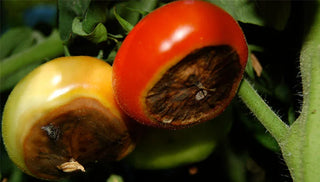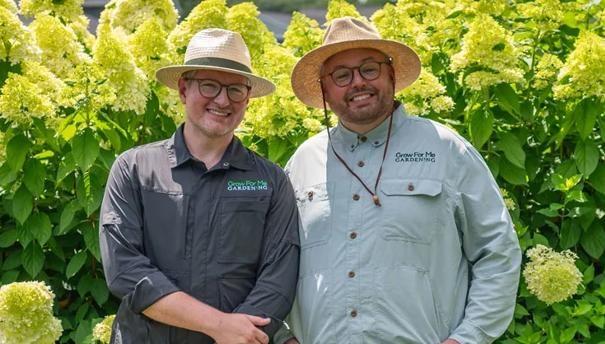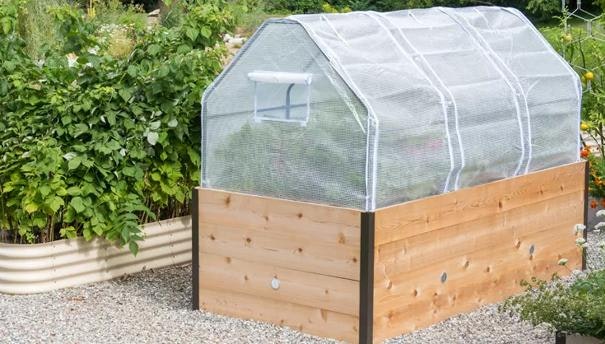What is Tomato Blossom End Rot?
Blossom end rot is a common garden physiological disorder caused by a lack of calcium within the plant. It can occur in pepper, squash, cucumber, and melon fruits as well as tomatoes. It is NOT caused by an insect (so don't attempt to apply insecticide all over your garden).
 Photo: Susan Romanoff
Photo: Susan Romanoff
Blossom end rot is most common when the growing season starts out wet and then becomes dry when fruit is setting. A water-soaked spot at the blossom end of tomato fruits is the classic symptom of blossom end rot, and damage first appears when fruits are approximately half their full size.1 The water-soaked areas enlarge and turn dark brown and leathery. These areas will eventually begin to rot, so the fruit should be picked and discarded.
What causes Tomato Blossom End Rot?
Your garden soil may simply lack the necessary calcium needed for fruits to form. More commonly, however, the soil has plenty of calcium but the plant cannot take it up. Calcium is absorbed into plants when the water moves up through the roots and exits (evaporates) through the leaves.2 Several factors can limit a plant's ability to absorb enough calcium for proper development, including:
- fluctuations in soil moisture (too wet or too dry)
- an excess of nitrogen (N) in the soil3
- root damage due to cultivation
- excessively cold soil
- uneven or incomplete watering
How to Prevent Tomato Blossom End Rot
Avoid the cold: In cold climates, allow soil to warm before planting; cold soils limit nutrient uptake.
Maintain moisture: When the weather is dry, water thoroughly once or twice each week to moisten the soil to a depth of at least 6 inches. Soaker hoses or drip irrigation systems are ideal for this. Apply mulch, such as Red Tomato Mulch, to minimize evaporation and help maintain consistent soil moisture.
Get a soil test: Aim for a soil pH of at least 6.5-7.0.
Skip the N (nitrogen): Too much nitrogen can limit calcium absorption. Use fertilizers that are low in nitrogen and high in phosphorous, such as the GSC Organic Tomato Fertilizer.
Provide calcium: Use a calcium-based foliar fertilizer that can be sprayed right on the plant, such as Tomato Rot Stop. This works by providing calcium directly to the foliage.
Keep garden records: You may discover that some tomato varieties are more susceptible to blossom end rot than others.4
Blossom End Rot in Containers
Plants growing in containers can be particularly susceptible to blossom end rot. This is because roots can become packed in tightly which reduces the space for water. Growing in a larger container, watering more frequently, or using a drip irrigation can all help prevent blossom end rot.5 Watering during the day can also help the plants uptake water more immediately.
You can also mulch the top of the soil in your container to help reduce evaporation. Adding crushed egg shells, bonemeal, or additional fertilizers can also help increase the calcium in the soil. If growing tomatoes, tomato specific fertilizers can help even more. Ultimately, container growing requires more care to manage end rot.
Blossom End Rot FAQs
1. Is tomato blossom end rot caused by nutrient deficiency?
Yes, blossom end rot, in tomatoes and other plants, is caused by a lack of calcium in the plant. The lack of calcium causes a breakdown in the fruit which results in rot.
2. Is end rot treatable?
Yes! Through proper watering, planting, and fertilizing you can reverse end rot and get your plants healthy and producing beautiful fruit again.
3. Does calcium cause tomato blossom end rot?
A lack of calcium does, but this is more often a result of the plant not uptaking the calcium already in the soil than a lack of calcium. Proper mulching and watering can aid in the natural uptake of water.
4. Should I cut off rotted fruit and leaves?
Yes, removing fruit and leaves that have already started to rot will help the plant regain health faster. Combine this with proper treatment of the plant to help restore it to glory!
Sources
1 https://www.canr.msu.edu/news/blossom_end_rot_causes_and_cures_in_garden_vegetables
2 https://pmc.ncbi.nlm.nih.gov/articles/PMC4243668/
3 https://academic.oup.com/hr/article/11/10/uhae208/7723936
4 https://ipm.illinois.edu/diseases/series900/rpd906/
5 https://aces.nmsu.edu/ces/yard/2000/051300.html


 Tomato Rot Stop
Tomato Rot Stop

